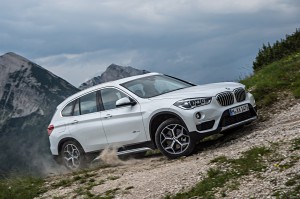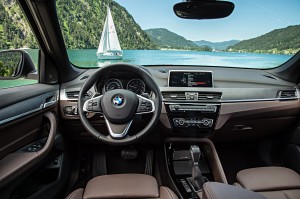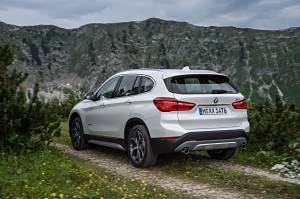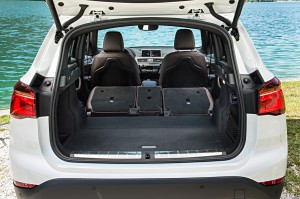
The 2016 BMW X1 is taller, longer and wider than its predecessor making for a more comfortable ride.
Lost in the hubbub surrounding the collapse of Harald Krueger, BMW’s CEO, is the fact the Bavarian brand has its next-gen luxury compact crossover, the X1, ready for the market just as sales in the segment are taking off.
The compact crossover area is growing not only in terms of the metal moved by dealers, but also in the number of companies participating in the arena. The luxury portion of the market is growing faster than the rest so the company’s timing is perfect.
The new X1 is is taller, wider and longer than its predecessor meaning that the smallest of BMW’s crossov, er, sports-activity vehicles has more room for passengers and a better view of the road for the driver.
Not only will the driver and passengers be more comfortable in the new model, they’ll be safer with the maker’s Driver Assistance Plus package. The technological array of equipment includes Lane Departure Warning, Speed Limit Info, Automatic High Beams, as well as Frontal Collision Warning with Pedestrian Warning and City Collision Mitigation.
In addition to these functions, the package also features the Active Cruise Control system with Stop & Go function. Park Distance Control and the Rear-View Camera are part of the Driver Assistance Package that transfers images onto the Control Display, making precise and comfortable parking maneuvers that much easier.
These safety functions are supplemented with practical and entertainment technologies routed through an optional high-resolution 8.8-inch Control Display with touchpad controller. It plays host to BMW Online, BMW Apps, Remote Services and provide Advanced Real-Time Traffic Information.
(BMW CEO Harald Krueger collapses during press conferences. For more, Click Here.)
As an option, a high-resolution 6.5-inch screen navigation with BMW Online, BMW Apps, Remote Services, Advanced Real Time Traffic Information is also available.
By adding to the functionality of the infotainment system the new BMW X1 allows for increased safety by simultaneously providing greater comfort, all based on user selection.
While there are plenty of options when it comes to the electronics and safety, in the U.S. there will be only one choice when it comes the engine powering the X1: a 2.0-liter, turbocharged, inline-four-cylinder putting out 228 horsepower and 258 pound-feet of torque. All-wheel drive is standard, as is an eight-speed automatic transmission.
(Click Here to find out how BMW is trying to redefine “the Ultimate Driving Machine.”)

Using an 8.8-inch Control Display with touchpad controller drivers can access BMW Online, BMW Apps and Advanced Real-Time Traffic Information.
The Germans make sure that the X1 handles well, equipping it with Servotronic speed-sensitive steering assistance as standard equipment. In addition to the steering, drivers enjoy a variety of handling setting with the Driving Dynamic Control switch on the center console.
The driver can set-up for a sportier, more comfort-oriented or efficiency-optimized character. Calling up Comfort, Sport or Eco Pro mode at the touch of a button adapts the responses of the accelerator pedal and steering as well as shift characteristics of the automatic transmission are also adjusted if the relevant equipment has been specified.
(To see how Ford filled in the performance blanks on the Focus RS, Click Here.)
The ride control system gets help from BMW’s Dynamic Stability Control stability system to improve the X1’s overall performance. The system includes Anti-lock Braking System, Dynamic Traction Control, Cornering Brake Control, Dynamic Brake Control, Brake Assist system, Brake Fade Compensation, Brake Drying Braking and Start-Off Assistant and Performance Control. The 2016 BMW X1 xDrive28i will arrive in US showrooms in Fall 2015.



BMW is about to prove that there’s one born every minute.
In the U.S. they can’t get enough SUVs so all of the auto makers are developing new product that they can’t sell hardly any place else except maybe Japan or the Middle East if they gold plate them.
Actually, GT, you’re wrong. Several of the automakers talked about this during the Frankfurt Motor Show, including Daimler’s Zetsche, Nissan’s Ghosn, Audi and VW officials and others. What began as a largely US phenomenon is now global. One of the fastest-growing segments worldwide is the compact CUV, ie the new Infiniti QX30 and BMW X1. It actually is a minor segment in the States but becoming huge in Europe and Asia. SUVs and CUVs were, until recently, insignificant in China. They are now wildly popular there. Europe is becoming a much more crossover-based market. It might seem counter-intuitive until you consider a couple factors: Europeans want small, fuel-efficient vehicles easy to maneuver and park in crowded cities, and good fuel economy. CUVs, in particular, offset the problems of small vehicles with easier access and higher seating. But new powertrains, better aero, lighter materials all help offset fuel economy issues. The data are there. Utes are now global.
Paul A. Eisenstein
Publisher, TheDetroitBureau.com
When I said SUVs I meant the real ones that are 5,000 lbs. plus not the Jeep Liberty sized mini utility vehicles. If you check Euro sales data for BMW, Audi and others you will see that X5, Q7, etc. sales are dropping and have been averaging around 10% of total sales. So I stand by my comment that the U.S. is the prime market for these behemoths and they do not sell in volume in other countries like they do in the U.S.
Smaller crossover type vehicles are a different story because consumers in areas where fuel is $5+/gal. will only buy a larger vehicle if the fuel economy is close to that of a typical car. VW has sold the Golf Plus for years. It is a taller and slightly longer version of the Golf platform that can have a third row of seats or more storage area. The key however is that it doesn’t weigh much more than the Golf car model and as such gets good fuel mileage for it’s size unlike the X5 or Q7.
BTW, any lighter materials that can be used on an SUV can also be used on a standard car so the fuel mileage gap isn’t really closing much between full sized SUVs and equally developed car models.
I don’t see hardly any SUVs when I am in Germany or Austria so I’d say that Europeans are not buying into the big boat SUV campaign. Small is what is practical for most of the world with excessive fuel costs. I can see a small SUV being viable in Europe and elsewhere but not the large SUVs. In contrast the small SUVs are less likely to be a hit in the U.S. as most people who buy SUVs in the U.S. want cargo or people capacity which a small SUV really can’t provide. SUVs are also a status symbol in the U.S. so a small SUV is unlikely to sell like the boats.
Note, Jorge, I included CUVs, as well as SUVs. Also recall that in a fleet of 200+ million vehicles, even if utes of all forms account for 30-40% % of this year’s new vehicles they will take a long time to become a major factor on a road network previously dominated by passenger cars. The data are there, however, and anecdotal observations aside, CUVs and SUVs are growing fast worldwide.
Paul E.